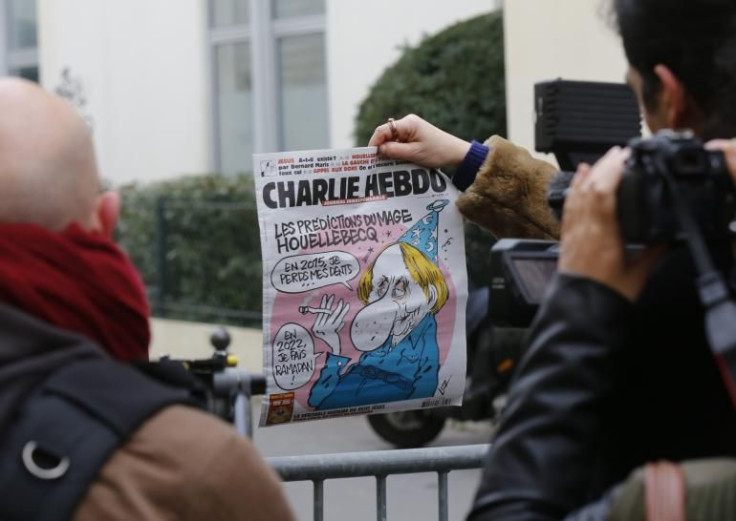Charlie Hebdo Muhammad Cartoons Force Newsrooms To Reevaluate Editorial Policies

In a fraction of a second, anyone with an Internet connection can see cartoon renderings of the Islamic Prophet Muhammad, cartoons that may have provoked Wednesday’s brutal mass shooting in Paris. It’s as simple as typing the words “Charlie Hebdo” into a Google search engine. Image results for that query -- the name of a French magazine known for lampooning religious figures -- will turn up rows upon rows of the very images that drew threats from radical Muslims for several years.
Censorship in the age of Google is an elusive thing; the Streisand Effect, not so much.
But the ease with which these images can be accessed online has done nothing to quell discussions over whether or not media outlets should republish them. Within hours of the terrorist attack that left 12 people dead at the Charlie Hebdo offices, news outlets began commenting on -- calling out, really -- other news outlets for choosing not to repost the cartoons in question. In one blog post, the media writer Jeff Jarvis called free speech a “journalistic responsibility,” not a mere privilege.
In a sense, the commentary represented old versus new: Many of the organizations that chose not to republish the cartoons were Old Guard media like the Associated Press, CNN and the New York Times. Conversely, many of those doing the finger-pointing were digital natives like BuzzFeed and Slate.
But the differences in editorial judgments were more than a clash of newsroom cultures; they were a line in the sand, one amplified on social media, where conversations about editorial procedures quickly descended into accusations that not republishing the images was a downright cowardly act -- tantamount to dishonoring the magazine staffers who died for exercising their freedom of speech.
Katy Culver, associate director of the Center for Journalism Ethics at the University of Wisconsin-Madison, said the issue is not so black and white. “I don’t think it’s a simple question of those who are republishing the images are right and those who are not republishing them are wrong,” she said. “There seems to be a vein of commentary on social media -- that any publication not republishing the cartoons at issue is somehow not standing in solidarity. I don’t buy that. I think it’s much more multilayered.”
Those layers, in part, begin with long-standing polices that existed long before the attack on Charlie Hebdo. Culver said she doubted that newsrooms are self-censoring the images out of fear of inciting further violence. Rather, she said, internal newsroom protocols often evolve over many years, and with a lot of trial and error. And they’re not blind to cultural sensitivities.
“This is not the first time we have explored the question of publishing these kinds of images,” she said. “This has been a contested ground for many, many years, and I think these policies developed from important conversations.”
Following criticism, some news outlets defended their decision not to publish the cartoons. In a statement to BuzzFeed, Paul Colford of the Associated Press cited a policy of not moving “deliberately provocative images.” The New York Times had a similar answer.
But where some outlets saw cause for restraint, others saw a journalistic duty to tell the whole story. “[We] published the cartoons because they are newsworthy and relevant to this tragic event,” a spokeswoman for the Huffington Post told International Business Times. “It’s our job to present all important facets of a story to our readers.”
Regardless of where you stand, journalists have to be afforded the freedom to make judgment calls, said Chris Peck, president of the American Society of News Editors. “I think the decision on whether to publish any editorial cartoons or commentary related to this shooting and the events around it must remain in the hands of editors,” he said. “That’s the bedrock of a free press.”
The varied opinions speak to the challenges of not only developing such policies, but also applying them consistently. The Washington Examiner was quick to point out Wednesday that the AP, despite its insistence that it shies away from “deliberately provocative images,” had no problem publishing photos of Andres Serrano’s 1987 photograph “Piss Christ.” The AP deleted the photograph after being called out on the inconsistency.
The Examiner surely delighted in its gotcha moment, but Culver said any policy over time is going to raise questions of consistency. “A policy is not etched in stone tablets,” she said. It’s something [newsrooms] continue to refine and update as new cases arrive.”
On Thursday, Dean Baquet, executive editor of the New York Times, echoed that idea. In an interview with the paper’s public editor, Margaret Sullivan, he said he changed his mind twice on Wednesday before deciding not to republish the photos out of respect to Muslim readers. “It had to be my decision alone,” he told Sullivan.
While that will certainly not be the last word on the matter, Culver said the real tragedy would be if discussions over editorial policies and judgment calls overshadowed the abject slaughter of 12 people. “The takeaway from this situation cannot be, ‘Was the Associated Press right to pixelate images?’” she said. “It has to be that free expression is under attack in barbaric ways -- and we have to rise to protect it.”
Christopher Zara is a senior writer who covers media and culture. Got a news tip? Email me here. Follow me on Twitter @christopherzara.
© Copyright IBTimes 2025. All rights reserved.






















